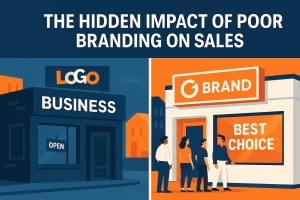
Introduction
Let’s be real—branding is more than just a fancy logo or a catchy tagline. It’s the soul of your business. It's how customers feel when they see your name or hear about your services. If your brand doesn’t leave the right impression, it could be silently killing your sales.
Understanding the Concept of Branding
Branding vs. Marketing
Branding is who you are. Marketing is how you get the word out. Many confuse the two, but branding is the foundation on which your marketing strategies stand.
Elements of a Strong Brand
- Clear mission and vision
- Consistent visual identity
- Compelling brand voice
- Deep connection with the target audience
The Direct Impact of Poor Branding
Customer Confusion and Lack of Trust
If your brand looks different on every platform or sends mixed messages, customers will be confused—and confused customers don’t buy. Trust is hard-earned and easily lost through inconsistent branding.
Decline in Perceived Value
People pay for perceived value. If your brand looks outdated or unprofessional, customers may assume your products or services are subpar, even if they’re excellent.
Reduced Customer Loyalty
A strong brand creates an emotional bond. Weak branding makes your business forgettable. Without that connection, customers won't think twice before switching to a competitor.
Branding and Sales – The Critical Connection
How Branding Influences Purchasing Decisions
Would you buy from a brand that feels sketchy or generic? Probably not. Your branding needs to inspire confidence and convey quality. The better your branding, the more likely people are to purchase.
The Role of Emotional Branding in Sales
Think of Apple or Nike—these brands make people feel something. Emotions drive decisions. Your brand should tap into those emotions to drive conversions.
Poor Branding = Poor Conversion
Even the best product can struggle if the branding doesn’t support it. If your website, social media, and ads look disjointed or amateurish, people will bounce.
Common Branding Mistakes to Avoid
Inconsistency in Messaging and Visuals
Switching colors, fonts, and tone across platforms? That’s branding suicide. Keep it consistent, or risk losing credibility.
Ignoring Target Audience Preferences
Your branding should speak directly to your ideal customer. If you’re missing that mark, you're wasting opportunities.
Overcomplicating Your Brand Identity
Simplicity wins. A confusing or overly complex brand identity can push people away.
Real-Life Examples of Poor Branding Impact
Case Study 1: A Failed Rebrand
Remember when Gap tried to change their logo overnight? Backlash was so intense, they reverted within a week. Poor branding decisions can spark public outrage and damage trust.
Case Study 2: Misalignment with Customer Values
Brands that miss cultural cues or misrepresent values often face boycotts and PR disasters. Authenticity matters more than ever.
The Cost of Poor Branding
Financial Losses
Every confused customer is a lost sale. Over time, poor branding can translate to thousands—or millions—in missed revenue.
Damaged Reputation
Inconsistent or amateur branding chips away at your reputation. Once it's gone, rebuilding trust is tough.
Missed Growth Opportunities
A weak brand may never reach its potential. Investors, partners, and customers all want to align with strong, professional brands.
Signs Your Branding Might Be Failing
- Engagement is low despite consistent posting
- Customers can’t recall your brand name or logo
- Website visitors leave quickly without taking action
How to Strengthen Your Brand
Conduct a Brand Audit
Look at everything—from your logo to your email tone. Is it consistent? Is it appealing to your target audience?
Clarify Your Brand Message
Simplify. What do you stand for? Why should people care?
Align with Customer Expectations
Use feedback, reviews, and analytics to ensure your branding hits the right notes.
The Role of Performance Marketing in Brand Success
Amplifying Brand Visibility
Performance marketing can put your brand in front of the right people—but it won’t work if your branding is weak.
Using Data to Optimize Branding Efforts
Track what resonates. Use data to improve your brand voice, visuals, and messaging for better results.
Branding in the Digital Age
Importance of Consistent Online Presence
People will check your website, social media, and ads. If your presence isn't cohesive, you lose credibility fast.
Leveraging Social Media to Build Brand Trust
Show behind-the-scenes. Share customer stories. Let people see and feel your brand’s personality.
Hiring Experts to Fix Branding Issues
When DIY Isn’t Enough
Sometimes, you’re too close to your brand to see what’s wrong. A professional eye can make all the difference.
Benefits of Professional Brand Strategy
From logos to messaging frameworks, pros can align your brand for long-term success.
Branding and Long-Term Business Growth
Building Brand Equity
A strong brand becomes an asset. It adds value to your business even beyond sales.
Sustaining Customer Relationships
Great branding doesn’t just attract—it retains. Loyal customers are the most profitable ones.
Conclusion
Your branding is either helping your business grow—or holding it back. Poor branding can sabotage even the best products or services, while a strong, consistent brand identity fuels long-term success. If you’re struggling to connect with your audience or seeing lackluster sales, it might be time to look inward.
Call to Action
Let our expert team guide you toward a brand that builds trust and drives results. Contact us today for a personalized strategy that connects branding and sales seamlessly.
FAQs
Q1: What’s the biggest sign of poor branding?
Low customer engagement and inconsistent messaging are major red flags.
Q2: Can poor branding actually affect sales?
Absolutely. Poor branding erodes trust and lowers conversion rates.
Q3: How can I tell if my branding needs a revamp?
Start with a brand audit. Look at feedback, analytics, and consistency across channels.
Q4: Is branding more important than marketing?
They go hand-in-hand. Branding builds the foundation; marketing delivers the message.
Q5: Should I hire a professional for branding?
If your branding isn’t connecting with your audience, hiring a pro is a smart move.
